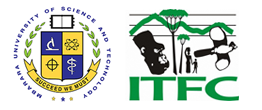The Institute of Tropical Forest Conservation dates as far back as 1983 with an ecological survey of Bwindi by Dr. Thomas M. Butynski, funded by the New York Zoological Society (now Wildlife Conservation Society). Butynski’s findings sparked the interest of the Worldwide Fund for Nature (WWF) to promote the conservation of Mountain gorillas from their habitat in SW Uganda.
In 1986, the Impenetrable Forest Conservation Project (IFCP) begun, with support from WWF. The project's mission was to protect last remaining Afro-montane forests of southwest Uganda; Bwindi, Mgahinga and Echuya.
F.l.t.r. Tom Butynski, Jan Kalina, John Miskell, John Ashe (1990, courtesy Bob Drewes)
The following year IFCP entered a long-term partnership collaborations with CARE to develop the Development Through Conservation Project, providing benefits to local communities. At the same time, influential people like Professor Frederick Kayanja (Vice Chancellor of Mbarara University of Science and Technology) and Dr. Erick Edroma put pressure on the Government of Uganda to improve the conservation status of several of the countries Forest Reserves.
In August 1991, the Impenetrable Forest and Mgahinga Forest Reserves were re-gazetted as Bwindi Impenetrable National Park and Mgahinga Gorilla National Park.
In the same year, the Institute of Topical Forest Conservation (ITFC) was established, to ensure the continuation of the IFCP’s conservation, research and training activities. ITFC is a research institute under Mbarara University of Science and Technology (MUST). Here is a full and detailed document to the establishment of ITFC as an Institute of MUST
ITFC has developed significantly in terms of infrastructure and human resource. The institute has a well equipped office, a specialist library, herbarium and basic laboratory, a ‘conservation education centre’ and accommodation for its staff as well as for up to 40 visitors (students, trainees, researchers). Solar panels and a back-up generator ensure permanent power supply and a satellite internet link ensures communication and access to information.
